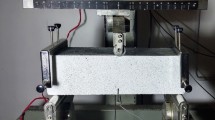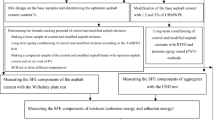Abstract
The effect of processing conditions (dynamic compaction) on the fatigue crack propagation behaviour of AC-20 asphalt concrete mixture was studied. Beams were prepared from AC-20 asphalt binder containing 8% asphalt by weight with and without dynamic compaction. The gradation used was Ohio Department of Transportation item 403, and was kept the same. Flexural static tests were conducted to determine the effect of dynamic compaction on both the ultimate strength and flexural modulus. Flexural fatigue tests were conducted on three identical notched specimens prepared using each of the two compaction techniques. Parameters controlling the crack propagation process were evaluated; namely, the energy release rate and the change in work, W i expended on damage formation and history dependent viscous dissipation processes within the active zone (region ahead of the crack tip). The modified crack layer (MCL) model was employed to extract the specific energy of damage, γ′, a material parameter characteristic of the asphalt concrete mixture's resistance to crack propagation, and the dissipative coefficient, β′. It has been found that the dynamically and statically compacted AC-20 mixture displayed superior fracture resistance, as reflected in γ′ and β′. Also, the ultimate strength and modulus increased by about two-fold. Scanning electron microscopic examination revealed an obvious change in the morphology of the fracture surface. This is manifested in the appearance of a finer more dense texture in the case of the dynamically and statically compacted mixture. In addition, smaller more frequent dimples in binder rich areas are indicative of better adhesion between the binder and the aggregate. This in turn contributes to the increased fracture resistance of the dynamically and statically compacted AC-20 asphalt concrete mixture.
Similar content being viewed by others
References
A. O. Abd El-Halim and O. Svec, in Proceedings of Canadian Technologists Asphalt Association, Vol. 35, 1990, (Polyscience Pub. Inc., Quebec, Canada) pp. 18–33.
J. Kindberg, ibid. Vol. 35, 1990, pp. 276–286.
A. Consuegra, D. N. Little, H. Von Quintus and J. Burati, Transportation research record 1228, Transportation Research Board, National Research Council, Washington, DC (1989) pp. 80–87.
C. L. Monismith, K. E. Secor and E. W. Blackmer, in Proceedings of the Association of Asphalt Paving Technologists, Vol. 30, 1961, (Charlston, SC) p. 188–222.
C. L. Monismith, “Asphalt mixture behavior in repeated flexure”, Report No. TE 64-2, University of California, Berkeley.
P. S. Pell, in Proceedings of the First International Conference on the Structural Design of Asphalt Pavements, 1962 (University of Michigan, Ann Arbor, MI) p. 310.
P. S. Pell and I. F. Taylor, in Proceedings of the Association of Paving Technologists, 1969, Vol. 37, Los Angeles, CA, pp. 423–458.
K. Majidzadeh, E. Kauffman and C. Saraf, in ASTM STP 508, American Society for Testing and Materials, Philadelphia, PA, 1972, pp. 67–83.
K. Majidzadeh and D. Ramsamooj, “Applications of fracture mechanics for improved design of bituminous concrete”, FHWA Report, FHWA-RD-76-91, June 1976, Federal Highway Administration.
P. F. Germann and R. L. Lytton, “Methodology for predicting the reflection cracking life of asphalt concrete overlays”, Report No. TT-2-8-75-207-5, Texas Transportation Institute, College Station Texas, 1979.
H. Aglan, Int. J. of Damage Mech. 2 (1993) 53.
H. Aglan, I. Shehata, L. Figueroa and A. Othman, “Structure-fracture toughness relationship of asphalt concrete mixtures”, Transportation Research Record No. 1353, (Transportation Research Board, National Research Council, Washington DC, 1992) pp. 24–30.
H. Aglan and L. Figuer, J. Eng. Mech. 119 (1993) 1243–1259.
Author information
Authors and Affiliations
Rights and permissions
About this article
Cite this article
Aglan, H., Othman, A. & Figueroa, L. Processing conditions—fracture toughness relationships of asphalt concrete mixtures. Journal of Materials Science 29, 4786–4792 (1994). https://doi.org/10.1007/BF00356524
Received:
Accepted:
Published:
Issue Date:
DOI: https://doi.org/10.1007/BF00356524




